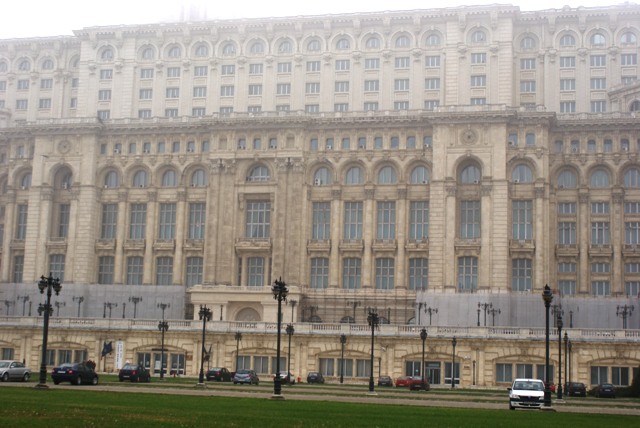The House of the People aka The Palace of the Parliament
The following is an excerpt from the book Single White Female Backpacker from the Teresa the Traveler Series.
After purchasing seats for the 1:30pm train, we had some time to explore. We had heard about a monstrosity called the Palace of the
Parliament and paid it a visit.
The palace was the brainchild of Nicolae Ceausescu, the last of the communist dictators, who ruled Romania from 1965 until 1989. After World War II Romania was occupied by the Soviet Union who forced King Michael I to abdicate before forming the communist People’s Republic. During his leadership, Ceausescu attempted to reshape Bucharest by demolishing over one fifth of the city center including churches and historic buildings to shape his vision. Part of this building spree included the Palace of the Parliament which started construction in 1983 after flattening a significant number of churches, synagogues and residences to make space
Parliament and paid it a visit.
The palace was the brainchild of Nicolae Ceausescu, the last of the communist dictators, who ruled Romania from 1965 until 1989. After World War II Romania was occupied by the Soviet Union who forced King Michael I to abdicate before forming the communist People’s Republic. During his leadership, Ceausescu attempted to reshape Bucharest by demolishing over one fifth of the city center including churches and historic buildings to shape his vision. Part of this building spree included the Palace of the Parliament which started construction in 1983 after flattening a significant number of churches, synagogues and residences to make space
|
Given the fact that most Romanians were living in poverty at the time, the building was considered a bit lavish to say the least. Building the palace was not the only unpopular move made by Ceausescu. In 1966 he initiated a decree banning abortion and contraception in an attempt to increase the low birth rate then later introduced a tax for those who remained childless after the age 25, and giving significant benefits to mothers of at least 5 children. Mothers of ten or more were declared Heroine Mothers by the Romanian state. His policy was so effective that the population began to grow, however, so did the poverty levels.
Large numbers of homeless children filled the urban streets as poor people started to abandon them. The population also suffered from a raging AIDS epidemic in the late 80’s which was ignored by a regime that refused to allow testing for HIV. By 1989, most Romanians were living well below the poverty line as the regime tried to pay back the huge debt it incurred by borrowing from the West to fund building projects. Food was rationed and people had to wait in huge lines to obtain basics such as bread. |
During this time Ceausescu, who was living in complete denial, was often filmed entering stores filled with supplies that were conveniently placed there prior
to his visits.
In December of 1989, Ceausescu’s regime collapsed after a series of violent events including a student anti-government protest at which military and police fired at demonstrators. On December 21st a huge meeting at University Square (now called revolution Square), intended to support the dictator turned into a riot as crowds began to boo Ceausescu and his wife. The following day the revolution spilled over into Romania’s other large cities forcing the couple to flee the capital by helicopter. They were eventually captured by police and turned over to the army who sentenced them to death in a military court on charges ranging from genocide to illegally gathering wealth. On December 22nd 1989, Nicolae and his wife were executed by firing squad marking the end of a Communist regime which arbitrarily killed and imprisoned people putting between 60,000 and 80,000 political opponents into “psychiatric centers” where they received sadistic treatment by doctors.
Romania then began to grow as a democracy becoming a member of NATO in 2004 and part of the European Union in 2007.
Unfortunately we did not have enough time to take a tour of the palace so we opted to wander around the city instead. Bucharest was definitely a city that has suffered from years of neglect. Abandoned buildings littered the downtown, rubbish filled the streets and most sidewalks were in a state of disarray. However, there were signs of improvement. I noticed some garbage collectors cleaning up the city and construction crews repairing sidewalks and repaving roads. The few
well preserved landmark buildings sat waiting for the rest of the city to catch up. Bucharest was once a beautiful city and hopefully she will
recapture her former glory.
to his visits.
In December of 1989, Ceausescu’s regime collapsed after a series of violent events including a student anti-government protest at which military and police fired at demonstrators. On December 21st a huge meeting at University Square (now called revolution Square), intended to support the dictator turned into a riot as crowds began to boo Ceausescu and his wife. The following day the revolution spilled over into Romania’s other large cities forcing the couple to flee the capital by helicopter. They were eventually captured by police and turned over to the army who sentenced them to death in a military court on charges ranging from genocide to illegally gathering wealth. On December 22nd 1989, Nicolae and his wife were executed by firing squad marking the end of a Communist regime which arbitrarily killed and imprisoned people putting between 60,000 and 80,000 political opponents into “psychiatric centers” where they received sadistic treatment by doctors.
Romania then began to grow as a democracy becoming a member of NATO in 2004 and part of the European Union in 2007.
Unfortunately we did not have enough time to take a tour of the palace so we opted to wander around the city instead. Bucharest was definitely a city that has suffered from years of neglect. Abandoned buildings littered the downtown, rubbish filled the streets and most sidewalks were in a state of disarray. However, there were signs of improvement. I noticed some garbage collectors cleaning up the city and construction crews repairing sidewalks and repaving roads. The few
well preserved landmark buildings sat waiting for the rest of the city to catch up. Bucharest was once a beautiful city and hopefully she will
recapture her former glory.
For tips on visiting Europe CLICK HERE
For general travel tips on what to pack and how to plan ahead CLICK HERE
For tips on travelling on a budget CLICK HERE
For general travel tips on what to pack and how to plan ahead CLICK HERE
For tips on travelling on a budget CLICK HERE
|
|
|
Where I stayed...
Hotel Carpati #16 Matei Millo Street, sect 1 Bucharest, Romania Tel: 40.21-31.50.14.0 Email: [email protected] Website: www.imparatulromanilor.ro This is a clean and quiet one star hotel in central Bucharest within walking distance to a McDonalds and has free wireless internet |



